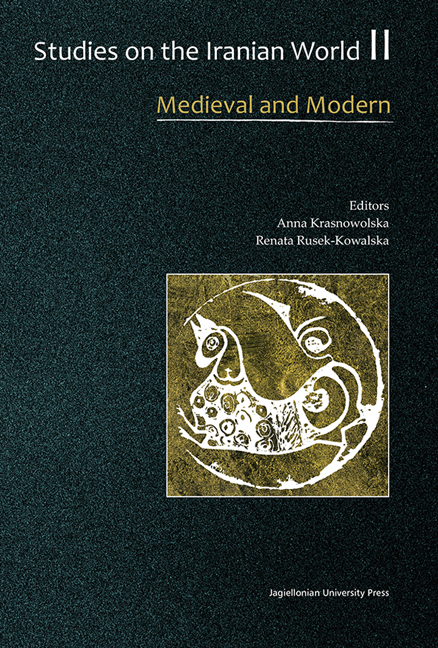Book contents
- Frontmatter
- Contents
- Foreword
- Linguistics
- Literature
- Timurid Authority and the Ottoman Sultan: Some Notes on Three Jāmi Manuscripts from the Library of Bayezid II (886–918/1481–1512)
- The Historical Novel in Early Modern Persian Literature
- Sibā-Zeynab-Zibā: the Metamorphoses of an Iranian Woman
- Laughing at Adultery in Persian Literature and Culture
- Quiet Lives and Looming Horrors – Subversive Narrative Strategies in the Earliest Short Stories of Zōyā Pīrzād
- Religion
- History
- Arts
- Social and Cultural Studies
Quiet Lives and Looming Horrors – Subversive Narrative Strategies in the Earliest Short Stories of Zōyā Pīrzād
from Literature
Published online by Cambridge University Press: 12 January 2018
- Frontmatter
- Contents
- Foreword
- Linguistics
- Literature
- Timurid Authority and the Ottoman Sultan: Some Notes on Three Jāmi Manuscripts from the Library of Bayezid II (886–918/1481–1512)
- The Historical Novel in Early Modern Persian Literature
- Sibā-Zeynab-Zibā: the Metamorphoses of an Iranian Woman
- Laughing at Adultery in Persian Literature and Culture
- Quiet Lives and Looming Horrors – Subversive Narrative Strategies in the Earliest Short Stories of Zōyā Pīrzād
- Religion
- History
- Arts
- Social and Cultural Studies
Summary
SUMMARY
This paper discusses a feature of the narrative style of the Persion fiction writer Zōyā Pīrzād in her first collection of short stories ‘Like all the afternoons’ (1991), namely subversive narrative strategies, i.e. strategies with a potential to counteract the story as it is told expressly by the narrator. The short stories ‘The rabbit and the tomato’, ‘The neighbours’, and especially ‘The stain’ are discussed in view of narrative elements applied to that effect (mise en abyme, parallel settings, title focus, unreliable narrator). The ambiguity of the short stories’ contents resulting from subversive narrative strategies is proposed as a factor contributing to Pīrzād's success with the readers.
The works of the Persian fiction writer Zōyā Pīrzād (born in Ābādān 1952; in the following ZP) have received considerable attention. The many reprints, translations, and prizes awarded to her works2 are all indicators of the favourable reception both by readers and institutions of literary criticism.3 One point of scholarly interest is ZP's narrative style, especially in her later works, but also in her earlier ones, including the one focused on here, her first collection of short stories Mes̱l-e hame-ye ʻaṣrhā ‘Like all the afternoons.’
One typical feature of ZP's style is that protagonists are characterized by hints at mental processes via gestures rather than by naming them. Another feature proposed here is that the characterizations of some protagonists are conveyed even more implicitly: by narratives that subvert the portraits presented on the surface. Such strategies on the level of the narrative that compromise the situations described by the narration are what is referred to here as subversive narrative strategies, and subversive narrative strategies in Mes̱l-e hame-ye ʻaṣrhā will be our object.
Mes̱l-e hame-ye ʻaṣrhā contains (depending on the edition) 15 to 18 short stories; they cover 2 to 7 pages in length and are told by various types of narrators; most of them are realist depictions of fictitious realities, with rare resorts to the fantastic; they evolve around one to four central characters – most, but not all of which are women; the majority is set indoors, but there are also some outdoor settings such as a staircase and an antique store.
- Type
- Chapter
- Information
- Studies on the Iranian WorldMedieval and Modern, pp. 107 - 116Publisher: Jagiellonian University PressPrint publication year: 2015

